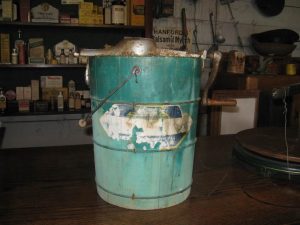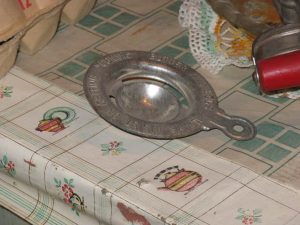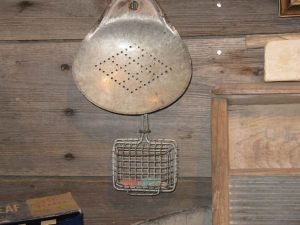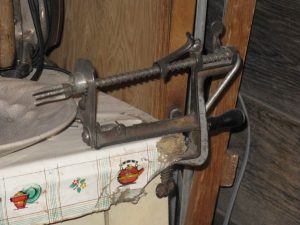Technology in the kitchen – the old is new
Most museums have kitchen displays, and this week’s topic is kitchen technology. In the traditionally-set up kitchen display, visitors usually comment on the quaintness of the old-time kitchen utensils but the implications of kitchen technology are seldom explored. In actuality, kitchens hold history hostage; they represent human advances (for the most part) in time saving, resources, marketing, resourcefulness, and food safety. Some items become obsolete through technology; others continue to be improved through use. Researching kitchen items offers the chance to examine evolutionary stages in product development, as well as changes in availability of certain materials.
Sometimes the old is new again. Items come back in vogue because they last longer and do a better job.
The following images are from the Armstrong-Spallumcheen Museum in Armstrong, BC. Here’s a bit more information about each one. The next time you’re in a small museum, don’t skip by the kitchen! Stop and appreciate technology.
Take for example, butter molds (image #1). If there were such a thing as a butter mold in use today, it would not likely be made out of wood. Yet the fact that butter molds existed in the past points out the move towards standardized sizing in marketing a product. You can probably buy butter molds today – but they would likely be made of plastic. Did wood impart a flavour to butter that’s now absent?
 Some modern forms of antique equipment are still in use. Image #2 – the ice cream maker – can be found in stores today, most commonly given as a gift (I’m making an educated guess here) and after a few uses, relegated to a back cupboard. As fascinating as the science of ice cream is, it’s much easier to just buy a carton. A kid-friendly method of making ice cream using two plastic bags makes the rounds in schools now and then. Gone are the days when an entire community got together to have a picnic that featured hand-churned ice cream.
Some modern forms of antique equipment are still in use. Image #2 – the ice cream maker – can be found in stores today, most commonly given as a gift (I’m making an educated guess here) and after a few uses, relegated to a back cupboard. As fascinating as the science of ice cream is, it’s much easier to just buy a carton. A kid-friendly method of making ice cream using two plastic bags makes the rounds in schools now and then. Gone are the days when an entire community got together to have a picnic that featured hand-churned ice cream.
 Image #3 – the egg separator – is one of those gag gifts that has oddly lasted, and just as oddly, has never worked as well to separate egg whites from egg yolks as cracking an egg in half and pouring the white and yolk from one half to the other. Even pouring the contents of a cracked egg through your fingers works better than an egg separator.
Image #3 – the egg separator – is one of those gag gifts that has oddly lasted, and just as oddly, has never worked as well to separate egg whites from egg yolks as cracking an egg in half and pouring the white and yolk from one half to the other. Even pouring the contents of a cracked egg through your fingers works better than an egg separator.
 Image #4 makes me glad I live in a time of abundance, where soap does not have to made from ashes, lye and animal fat, and soap chips do not have to be carefully strained and saved so that they last longer.
Image #4 makes me glad I live in a time of abundance, where soap does not have to made from ashes, lye and animal fat, and soap chips do not have to be carefully strained and saved so that they last longer.
 Image #5 is an Okanagan invention (or it should be, if it isn’t) – an apple peeler. It would be so useful if a person happened to own a productive apple tree. The modern version is very little changed from this antique peeler, except that it comes in nicer, brighter colours.
Image #5 is an Okanagan invention (or it should be, if it isn’t) – an apple peeler. It would be so useful if a person happened to own a productive apple tree. The modern version is very little changed from this antique peeler, except that it comes in nicer, brighter colours.

